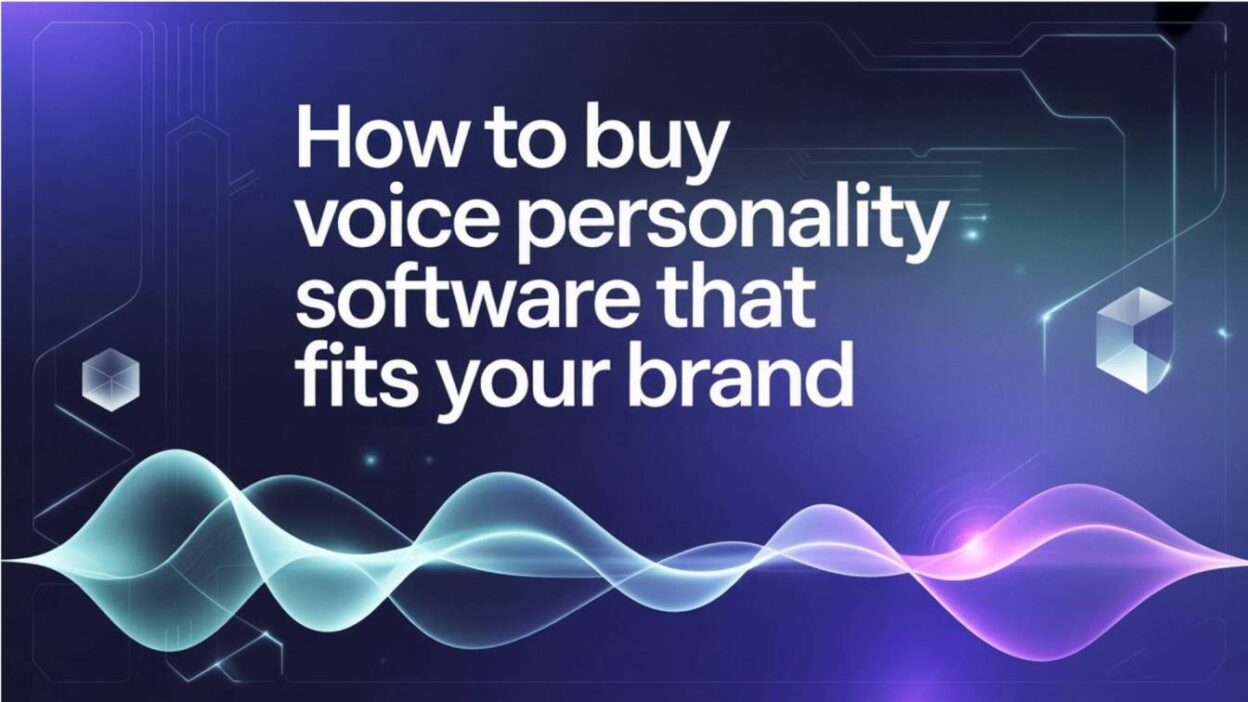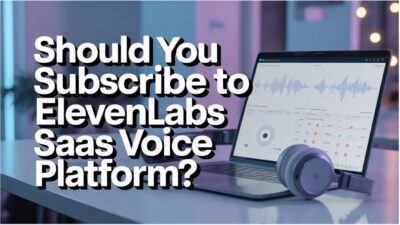Introduction
TL;DR The decision to buy voice personality software represents a critical investment in your brand’s customer experience strategy. Modern consumers expect personalized interactions across every touchpoint with your business. Voice technology has evolved from basic text-to-speech systems to sophisticated AI platforms that capture unique brand personalities.
Table of Contents
Your brand voice defines how customers perceive and remember your company during voice interactions. Generic robotic voices create disconnected experiences that fail to build emotional connections. Smart businesses recognize that voice personality directly impacts customer satisfaction and brand loyalty.
This comprehensive guide walks you through every consideration when you buy voice personality software for your organization. You will discover evaluation criteria, implementation strategies, and optimization techniques for maximum brand alignment.
Understanding Voice Personality Software
Voice personality software creates distinctive vocal characteristics that represent your brand during automated interactions. The technology combines artificial intelligence with advanced speech synthesis to generate natural-sounding voices. Modern platforms offer customization options that align vocal traits with brand identity elements.
Core Components of Voice Personality Technology
Speech Synthesis Engine: The foundation of voice personality software converts written text into spoken audio with natural intonation patterns. Advanced engines use neural networks to replicate human speech patterns accurately. Quality synthesis engines produce voices that sound authentic rather than mechanical.
Personality Parameter Controls: Sophisticated platforms provide adjustment controls for tone, pitch, speaking rate, and emotional expression. These parameters enable brands to create voices that match their desired personality characteristics. Fine-tuned controls ensure consistency across all customer interactions.
Emotional Intelligence Integration: Modern systems detect conversation context and adjust vocal delivery to match appropriate emotions. Empathetic responses build stronger customer connections during challenging interactions. Emotional awareness separates premium software from basic text-to-speech tools.
How Voice Personality Differs from Standard Text-to-Speech
Brand Alignment Capabilities: Standard text-to-speech tools offer limited customization options for voice characteristics. When you buy voice personality software, you gain extensive control over vocal attributes that reflect brand values. Customization ensures voice interactions reinforce brand identity consistently.
Natural Conversation Flow: Basic systems sound robotic and struggle with conversational nuances like pauses and emphasis. Advanced personality software incorporates natural speech patterns that make interactions feel human. Conversational quality significantly impacts customer perception and satisfaction.
Adaptive Communication Styles: Premium platforms adjust communication approaches based on customer responses and conversation context. Static systems deliver identical responses regardless of emotional or situational factors. Adaptive capabilities improve customer experience quality substantially.
Why Your Brand Needs a Custom Voice Personality
Building Emotional Connections with Customers
Voice personality creates memorable experiences that distinguish your brand from competitors. Customers form emotional attachments to brands that communicate with consistency and authenticity. Custom voices reinforce brand recognition across phone systems, virtual assistants, and automated services.
Trust Development Through Consistency: Consistent voice characteristics across all touchpoints build customer trust over time. Inconsistent voices create confusion and weaken brand perception. When you buy voice personality software with customization options, you ensure unified brand representation.
Emotional Resonance Impact: Voices evoke emotional responses that influence customer behavior and purchasing decisions. Warm, friendly voices create positive associations with your brand. Cold, mechanical voices distance customers and reduce engagement quality.
Brand Recall Enhancement: Distinctive voice personalities improve brand recall during future interactions and decision-making moments. Memorable voices keep your brand top-of-mind when customers need your products or services. Strong recall translates to increased customer lifetime value.
Competitive Differentiation Through Voice
Market Positioning Clarity: Your voice personality communicates market positioning through vocal characteristics and communication style. Luxury brands require different voice attributes than budget-focused companies. Strategic voice selection reinforces desired market perception effectively.
Customer Experience Excellence: Superior voice interactions create competitive advantages in crowded markets where products appear similar. Exceptional experiences drive customer loyalty and positive word-of-mouth marketing. Voice quality often determines whether customers recommend your brand to others.
Innovation Leadership Demonstration: Advanced voice personality technology signals innovation and customer-centricity to your target market. Early adopters gain reputational benefits as industry leaders in customer experience. Leadership positioning attracts premium customers and talented employees.
Key Features to Look for When You Buy Voice Personality Software
Customization and Flexibility Options
Voice Characteristic Controls: Look for platforms offering extensive control over pitch, tone, speed, and accent characteristics. Deep customization ensures your voice aligns perfectly with brand guidelines. Limited options force compromises that weaken brand representation.
Multiple Voice Profiles: Enterprise businesses need different voice personalities for various departments and customer segments. Customer service voices may differ from sales or technical support voices. Multi-profile capabilities provide appropriate voices for different contexts.
Brand Voice Guideline Integration: Premium software accepts existing brand voice guidelines as input for personality development. This integration ensures vocal characteristics match established brand communication standards. Seamless guideline implementation accelerates deployment timelines.
Natural Language Processing Capabilities
Context Understanding: Advanced systems comprehend conversation context to deliver appropriate responses with matching vocal delivery. Context awareness prevents awkward responses that confuse or frustrate customers. Sophisticated NLP separates industry-leading platforms from basic alternatives.
Multi-Language Support: Global businesses require voice personality consistency across multiple languages and regional dialects. Quality translations maintain personality characteristics despite language differences. Language capabilities expand addressable markets significantly.
Accent and Dialect Options: Regional customization allows voice personalities that resonate with specific geographic markets. Local accent familiarity increases customer comfort and trust during interactions. Dialect options demonstrate cultural awareness and respect.
Integration and Compatibility Requirements
Existing System Connectivity: When you buy voice personality software, verify compatibility with current phone systems and customer service platforms. Seamless integration prevents expensive infrastructure replacements and deployment delays. Technical compatibility assessments prevent costly implementation mistakes.
API Accessibility: Robust APIs enable custom integrations with proprietary systems and unique business processes. Flexible APIs future-proof investments as technology requirements evolve. Limited API access restricts innovation and customization potential.
Cloud vs. On-Premise Deployment: Evaluate whether cloud-based or on-premise solutions better match security requirements and technical capabilities. Cloud platforms offer scalability advantages while on-premise systems provide enhanced data control. Deployment model selection impacts long-term operational costs.
Evaluating Voice Personality Software Vendors
Vendor Experience and Reputation
Industry Track Record: Research vendor experience in your specific industry to understand relevant expertise levels. Industry specialists understand unique requirements and compliance considerations. Generic vendors may overlook critical sector-specific needs.
Client Success Stories: Request case studies and references from companies with similar size and industry characteristics. Real-world implementations reveal practical benefits and potential challenges. Success stories validate vendor claims and technology capabilities.
Innovation Investment: Assess vendor commitment to ongoing research and development for continuous platform improvement. Technology leadership requires sustained innovation investment over time. Vendors cutting R&D spending risk platform obsolescence.
Technical Support and Training
Onboarding Process Quality: Comprehensive onboarding programs accelerate time-to-value and reduce implementation friction. Poor onboarding leads to underutilization and disappointing results. Quality training ensures teams maximize platform capabilities.
Ongoing Support Availability: Evaluate support hours, response times, and escalation procedures for technical issues. Business-critical systems require responsive support with minimal downtime. Support quality directly impacts customer experience during technical problems.
Documentation and Resources: Extensive documentation enables self-service problem resolution and reduces support dependency. Knowledge bases, video tutorials, and community forums provide valuable learning resources. Comprehensive resources indicate vendor investment in customer success.
Pricing Models and Total Cost of Ownership
Subscription vs. Perpetual Licensing: Subscription models spread costs over time while perpetual licenses require larger upfront investments. Each model offers distinct advantages depending on cash flow and long-term plans. Cost structure preferences vary by organization and financial strategy.
Usage-Based Pricing Considerations: Some vendors charge based on voice interaction volume rather than flat subscription fees. Usage pricing works well for businesses with variable demand patterns. Flat pricing provides budget predictability for stable usage patterns.
Hidden Cost Identification: Uncover implementation fees, training costs, and upgrade charges before committing to vendors. Hidden costs dramatically impact total ownership expenses over multi-year periods. Transparent pricing enables accurate budget planning and vendor comparison.
Steps to Buy Voice Personality Software Successfully
Define Your Brand Voice Requirements
Brand Personality Assessment: Document core brand attributes, including formality level, emotional tone, and communication style preferences. Clear personality definitions guide voice characteristic selection during evaluation. Ambiguous requirements lead to misaligned voice selections.
Customer Persona Analysis: Understand target customer preferences and communication expectations across different segments. Different demographics respond to varying voice characteristics and interaction styles. Persona insights inform voice selection for maximum customer resonance.
Use Case Identification: List specific applications where voice personality software will enhance customer experiences. Customer service, sales inquiries, technical support, and appointment scheduling require different approaches. Use case clarity ensures platform capabilities match actual needs.
Create a Vendor Evaluation Framework
Feature Requirement Matrix: Develop weighted scoring systems that prioritize essential features over nice-to-have capabilities. Objective evaluation frameworks prevent emotional decisions and vendor manipulation. Systematic assessments identify optimal solutions efficiently.
Proof of Concept Planning: Request vendor demonstrations using your actual brand scripts and customer scenarios. Generic demos hide practical limitations and compatibility issues. Real-world testing reveals true platform capabilities and limitations.
Reference Check Process: Contact vendor references with specific questions about implementation challenges and ongoing satisfaction. Candid conversations uncover issues vendors may downplay during sales processes. Reference insights provide realistic expectations for your implementation.
Implementation Planning and Timeline
Technical Requirements Documentation: Specify integration points, data security requirements, and performance expectations before implementation begins. Clear requirements prevent scope creep and timeline delays. Documentation enables accurate resource planning and risk mitigation.
Phased Rollout Strategy: Launch voice personality software in limited applications before enterprise-wide deployment. Phased approaches enable learning and adjustment without risking customer experience. Gradual rollouts reduce implementation risk substantially.
Success Metrics Definition: Establish measurable objectives for customer satisfaction, interaction quality, and operational efficiency. Quantifiable metrics demonstrate ROI and guide ongoing optimization efforts. Clear success criteria maintain stakeholder alignment throughout implementation.
Customizing Voice Personality to Match Your Brand
Voice Characteristic Selection
Tone and Pitch Optimization: Select tonal qualities that match brand personality across the formal to casual spectrum. Professional services require different tones than entertainment brands. Pitch selections influence perceived authority and approachability levels.
Speaking Rate Calibration: Adjust speaking speed to match customer information processing preferences and conversation urgency. Fast-paced voices suit energetic brands while measured pacing conveys thoughtfulness. Speaking rate impacts comprehension and customer comfort.
Accent and Regional Considerations: Choose accent characteristics that resonate with primary customer demographics and geographic markets. Regional familiarity builds trust and reduces communication barriers. Accent selection requires cultural sensitivity and market research.
Emotional Range Development
Situational Emotion Mapping: Define appropriate emotional expressions for various customer scenarios, including sales, support, and complaints. Emotional alignment improves customer satisfaction and resolution effectiveness. Mismatched emotions damage brand perception and customer relationships.
Empathy Integration: Program empathetic responses for challenging customer situations requiring understanding and support. Empathy demonstrations build loyalty and diffuse tense interactions. Authentic empathy separates exceptional experiences from transactional encounters.
Enthusiasm Calibration: Balance enthusiasm levels to avoid overwhelming customers while maintaining engaging interaction energy. Excessive enthusiasm appears insincere while insufficient energy seems disinterested. Optimal enthusiasm levels vary by industry and customer type.
Testing and Refinement Process
Internal Stakeholder Feedback: Gather input from employees across departments regarding voice personality alignment with brand values. Internal consensus ensures company-wide support and consistent representation. Stakeholder buy-in facilitates smooth implementation and adoption.
Customer Testing Programs: Conduct limited customer trials to assess voice personality reception and effectiveness. Real customer feedback reveals perception gaps between intentions and reality. Customer validation prevents expensive mistakes after full deployment.
Iterative Optimization Cycles: Continuously refine voice characteristics based on performance data and customer feedback. Voice personality optimization requires ongoing attention rather than a one-time configuration. Iterative improvements maintain competitive voice quality standards.
Industry-Specific Considerations
Healthcare and Medical Applications
HIPAA Compliance Requirements: Healthcare voice systems must protect patient privacy through secure data handling and transmission. Compliance violations carry severe penalties and reputation damage. When you buy voice personality software for healthcare, verify complete regulatory compliance.
Empathy and Compassion Integration: Medical voice personalities require heightened empathy for patients experiencing health concerns. Compassionate communication improves patient satisfaction and treatment adherence. Clinical accuracy paired with emotional support delivers optimal patient experiences.
Medical Terminology Handling: Healthcare platforms need accurate pronunciation of complex medical terms and pharmaceutical names. Mispronunciations undermine credibility and confuse patients. Specialized medical voice libraries ensure accuracy.
Financial Services and Banking
Security and Trust Communication: Financial institutions require voice personalities that convey security, reliability, and trustworthiness. Trust signals reduce customer anxiety during sensitive financial discussions. Authority and warmth balance create optimal financial service voices.
Regulatory Compliance Disclosures: Banking voice systems must deliver required disclosures clearly while maintaining natural conversation flow. Compliance requirements should not compromise customer experience quality. Seamless disclosure integration demonstrates technical sophistication.
Fraud Prevention Sensitivity: Security-related communications require serious tones without creating unnecessary customer alarm. Balanced fraud messaging maintains vigilance while preserving customer confidence. Tone calibration prevents panic while ensuring appropriate caution.
E-commerce and Retail
Brand Personality Amplification: Retail voices should amplify brand personality characteristics that differentiate from competitors. Distinctive voices create memorable shopping experiences that encourage repeat purchases. Personality amplification strengthens brand identity in crowded markets.
Promotional Enthusiasm: Sale announcements and promotional messages benefit from enthusiastic delivery without appearing pushy. Genuine excitement about offerings increases customer interest and conversion rates. Authenticity separates engaging promotions from annoying advertisements.
Product Recommendation Tone: Helpful recommendation voices build trust, while suggestive selling approaches may alienate customers. Consultative tones position businesses as advisors rather than aggressive sellers. Recommendation style impacts customer receptiveness significantly.
Technical Integration and Deployment
System Architecture Planning
Infrastructure Requirements: Assess server capacity, bandwidth needs, and processing power for voice personality software operation. Insufficient infrastructure causes performance issues that degrade customer experiences. Proper capacity planning prevents technical bottlenecks.
Data Flow Mapping: Document how customer data moves between voice systems and other business applications. Clear data flow understanding prevents security vulnerabilities and integration failures. Mapping reveals optimization opportunities and potential risks.
Failover and Redundancy: Implement backup systems that maintain service during technical failures or maintenance periods. Voice system downtime directly impacts customer experience and revenue. Redundancy investments prevent costly outages.
Security and Privacy Protection
Data Encryption Standards: Verify the voice software employs industry-standard encryption for data transmission and storage. Weak encryption exposes customer information to security breaches. Strong security protects brand reputation and customer trust.
Access Control Implementation: Restrict voice personality configuration access to authorized personnel only. Unauthorized modifications could damage brand representation and customer experiences. Proper access controls prevent accidental and malicious changes.
Audit Trail Maintenance: Maintain detailed logs of voice system interactions and configuration changes for security and compliance. Audit trails enable incident investigation and regulatory reporting. Comprehensive logging demonstrates security commitment.
Performance Monitoring and Optimization
Quality Metrics Tracking: Monitor voice clarity, response accuracy, and conversation completion rates continuously. Performance degradation requires immediate investigation and resolution. Proactive monitoring maintains consistent customer experience quality.
Customer Satisfaction Measurement: Collect feedback on voice interactions through surveys and sentiment analysis. Customer perception guides optimization priorities and validates technology investments. Regular feedback collection enables continuous improvement.
Usage Analytics Review: Analyze interaction volumes, peak times, and common conversation paths for capacity planning. Usage patterns reveal optimization opportunities and infrastructure needs. Data-driven decisions maximize voice system effectiveness.
Common Mistakes to Avoid
Prioritizing Cost Over Quality
Short-Term Savings Traps: Cheap voice personality software often delivers poor experiences that damage brand perception. Customer dissatisfaction costs exceed initial savings many times over. Quality investments pay dividends through superior customer experiences.
Hidden Technical Debt: Inferior platforms require extensive customization and ongoing maintenance that accumulates costs over time. Technical debt ultimately exceeds premium platform costs while delivering inferior results. Quality platforms reduce long-term total ownership costs.
Scalability Limitations: Budget platforms may lack scalability for business growth and increasing interaction volumes. Migration costs to adequate platforms disrupt operations and frustrate customers. Scalable solutions accommodate growth without platform changes.
Ignoring Brand Alignment
Generic Voice Selection: Accepting default voice options without customization fails to differentiate your brand. Generic voices create forgettable experiences that provide no competitive advantage. When you buy voice personality software, invest time in proper customization.
Inconsistent Cross-Channel Experience: Voice characteristics that differ from other brand touchpoints create confusion and weaken identity. Consistent experiences across channels reinforce brand recognition and trust. Integration planning ensures unified brand representation.
Cultural Insensitivity: Voice characteristics that offend or alienate customer segments damage brand reputation. Cultural awareness during voice selection prevents expensive mistakes. Diversity consultation improves voice appropriateness.
Inadequate Testing and Validation
Limited Scenario Coverage: Testing only common use cases misses edge cases that frustrate customers during real interactions. Comprehensive testing reveals potential issues before customer exposure. Thorough validation prevents reputation damage.
Skipping Customer Feedback: Internal assessments alone cannot predict customer reception and satisfaction. Customer validation provides reality checks on internal assumptions. Direct feedback prevents disconnects between intentions and perceptions.
Rushing Implementation: Accelerated deployments without proper testing risk customer experience disasters. Quality implementation requires adequate time for testing and refinement. Patience during implementation prevents costly mistakes.
Measuring Success and ROI
Customer Experience Metrics
Satisfaction Score Improvements: Track customer satisfaction changes before and after voice personality implementation. Positive trends validate technology investments and optimization efforts. Satisfaction improvements correlate with revenue growth.
First Contact Resolution Rates: Monitor whether voice interactions resolve customer needs without escalation or callbacks. Higher resolution rates indicate effective voice personality and system capabilities. Resolution efficiency reduces operational costs.
Customer Effort Scores: Measure perceived ease of voice interactions from customer perspectives. Lower effort scores indicate intuitive voice experiences that customers appreciate. Effort reduction drives loyalty and repeat business.
Operational Efficiency Gains
Call Handling Time Reduction: Compare average interaction durations before and after voice personality software implementation. Efficient voice interactions reduce operational costs and serve more customers. Time savings demonstrate tangible ROI.
Agent Escalation Rate Tracking: Monitor how often voice systems transfer customers to human agents for assistance. Lower escalation rates prove the voice system’s effectiveness and capability. Reduced escalations and lower staffing requirements.
Self-Service Adoption Rates: Track customer willingness to use voice self-service options versus demanding human assistance. Higher adoption indicates customer confidence in voice technology. Self-service preference reduces operational costs significantly.
Business Impact Analysis
Revenue Attribution: Calculate revenue generated through voice-assisted sales and conversions. Direct revenue attribution proves business value beyond customer experience improvements. Revenue impact justifies continued investment and expansion.
Customer Retention Improvements: Analyze retention rate changes following voice personality implementation. Better experiences reduce churn and increase customer lifetime value. Retention improvements provide substantial long-term value.
Cost Per Interaction Calculation: Determine the total cost for each customer voice interaction, including technology and staffing expenses. Lower costs per interaction improve overall operational efficiency. Cost reductions enable budget reallocation to growth initiatives.
Future-Proofing Your Voice Personality Investment
Emerging Technology Considerations
AI and Machine Learning Integration: Select platforms incorporating artificial intelligence for continuous voice personality improvement. Machine learning enables automatic optimization based on interaction outcomes. AI capabilities ensure long-term competitive positioning.
Multimodal Experience Support: Future voice systems will integrate with visual interfaces for comprehensive customer experiences. Multimodal capabilities expand application possibilities and customer satisfaction. Forward-looking platforms prepare for convergent experiences.
Emotional Intelligence Advancement: Next-generation systems will detect and respond to customer emotions with unprecedented accuracy. Emotional AI represents the future of personalized customer experiences. Early adoption provides competitive advantages.
Scalability and Growth Planning
Volume Capacity Planning: Ensure platforms handle anticipated growth in voice interactions over 3-5 year periods. Inadequate capacity requires expensive migrations during critical growth phases. Scalable architecture accommodates success without disruption.
Geographic Expansion Readiness: Select solutions supporting international expansion through language and cultural customization. Global capabilities enable market expansion without technology constraints. International readiness accelerates growth opportunities.
Channel Expansion Flexibility: Choose platforms that adapt to emerging customer communication channels beyond current applications. Channel flexibility future-proofs investments as customer preferences evolve. Rigid platforms limit strategic options.
Read More: Best AI Call Escalation Solutions for Growing Businesses
Conclusion

The decision to buy voice personality software significantly impacts your brand identity and customer experience quality. Strategic selection processes ensure technology investments align with brand values and business objectives. Comprehensive evaluation prevents costly mistakes that damage customer relationships.
Voice personality customization creates distinctive brand experiences that differentiate your business from competitors. Generic solutions deliver forgettable interactions while customized voices build emotional connections. Investment in proper customization pays dividends through enhanced brand recognition and loyalty.
Successful implementation requires careful planning, thorough testing, and ongoing optimization based on performance data. Rushed deployments risk customer experience disasters that undermine technology benefits. Patient, methodical approaches ensure positive outcomes and stakeholder satisfaction.
When you buy voice personality software, you invest in your brand’s future and customer relationship quality. Premium solutions deliver superior experiences that justify higher initial costs through better outcomes. Quality voice technology becomes a strategic asset rather than an operational expense.
Begin your voice personality journey today by defining brand requirements and evaluating leading platforms. The right voice personality software transforms customer interactions and strengthens brand positioning. Strategic technology investments create sustainable competitive advantages in voice-driven customer experiences.






[…] READ MORE:-How to Buy Voice Personality Software That Fits Your Brand […]